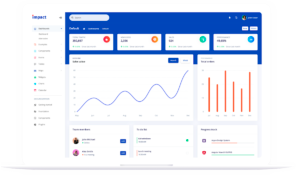Mastering remote team communication
8 min read
Communication is the most critical and complex ingredient of a successful remote team. The communication needs of a remote team are different. As a manager, you need to understand the nuances and challenges of communicating well in a remote team setting.
Before we dive into what you should do, let’s look at why remote teams need a different approach to communication.

Need for a different communication paradigm
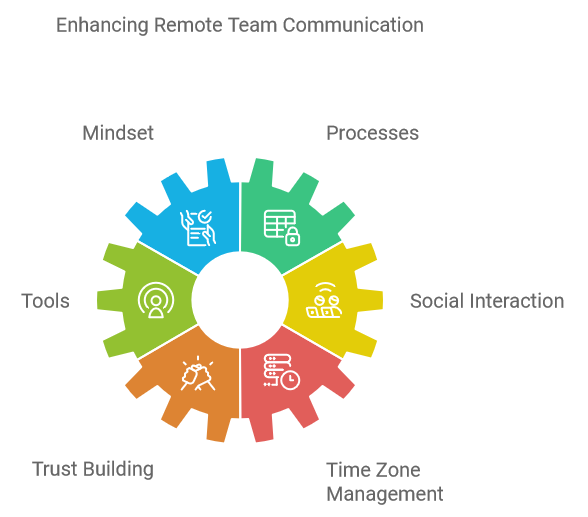
Working in an office enables communication at multiple levels and in different ways. There are far more opportunities to talk, discuss, and observe in an office. There are a lot of tools and infrastructure that facilitates communication between team members. Last but not the least, managers and team members know how to make the most of an office environment.
Your team members see and interact with each other every day in the office. It builds familiarity and a close relationship between them. People can walk up to others to have a chat. Team meetings are great for connecting and bonding as people discuss not just the work but also things of mutual interest.
Discussion rooms with whiteboards and projectors help people express themselves clearly to their team members. You can organize team events to build bonds. Then there are water cooler and pantry for informal chats about everything under the sun. In short, the office gives your team a great social life.
Now compare that to how your remote team operates. They don’t get to see and meet each other. There is no place to hang out and bond. People are not just physically separated, they are also not emotionally as connected as a team in the office. Team members may live in different time zones making it difficult to define common working hours for everyone.
The speed of communication is also different in a remote team. No immediate response and missed messages can cause people to second guess their messages. It can lead to anxiety and lack of trust. Remote teams clearly need a different mindset, processes, and tools to communicate effectively.
So how do you overcome these challenges? By doing the 11 things we discuss in this post.
1. Switch to video calls
This is the most effective way to improve communication and increase the performance of your remote team. To fully comprehend its impact, you need to understand the 3 Types of Distances in a Remote Team:
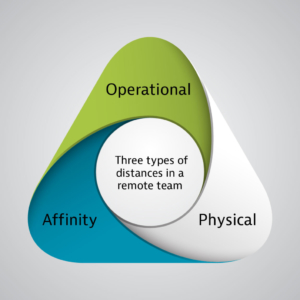
Physical – physical and time distance between team members.
Operational – the noise that can impede effective communication like differences in skill levels, size of the team and bandwidth
Affinity – issues that prevent your remote team from building deep, long-lasting relationships based on shared value, trust, and interdependency.
Out of these three, Affinity distance has the biggest impact on the long term performance of your team. This is where video communication is most effective as it helps the team members build emotional bonds with each other. Seeing each other regularly builds familiarity and bonding that’s difficult to do with faceless people in a conference call. The trust and emotional relationship video calls help develop are critical in helping the team overcome or reduce Affinity distance.
2. Change the way the team communicates in writing
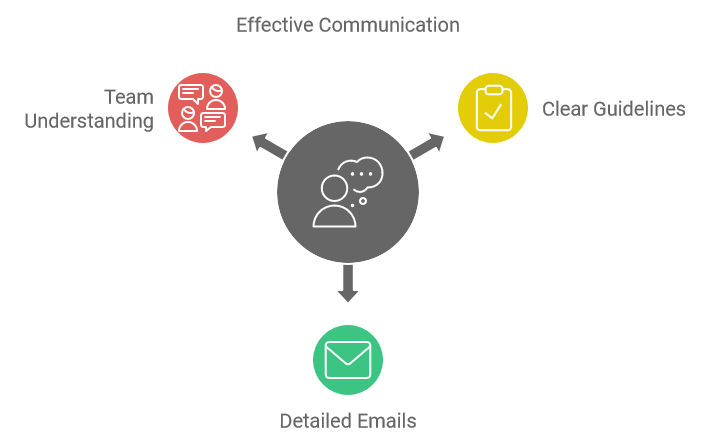
Most business teams use too many jargon, acronyms, and abbreviations. While these can help reduce the amount of text one needs to write, they can also cause confusion if everyone in the team does not know them. Create a dictionary or list of acronyms/abbreviations the team can use and prohibit the ones not included in it. It will make sure everyone knows where to look if he does not know it.
Another important change to make is to switch from brief, pithy emails to more detailed ones. Short emails are good for quick notes but not for explaining or communicating important issues. Coach your team to write detailed emails with as much information as possible. The idea is to avoid confusion and miscommunication.
Remember that it may be hours before some members can clarify things with each other because of time differences. Clear, detailed communication can save everyone time, misunderstanding, and sometimes, heartburn.
3. Don’t micromanage/watch over people’s shoulders
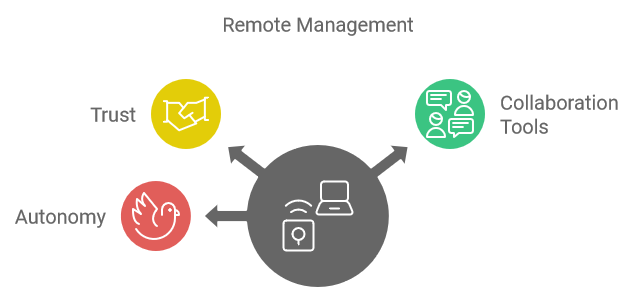
Managing remote teams is difficult as you can’t walk up to people to see what they are doing. Some people try to call team members multiple times in the day to check on the progress. While it may be all right to do it for urgent tasks, it’s not a good idea. Your team members are responsible adults, even when they work remotely.
A big part of effective remote working is to enable the team members, not to bombard them with calls and emails about their work. It’s important to make your team members feel trusted and wanted. Use tools to collaborate and track progress but resist the temptation of looking over their shoulder with intrusive tools and too many calls.
4. Decide which tools to use and how
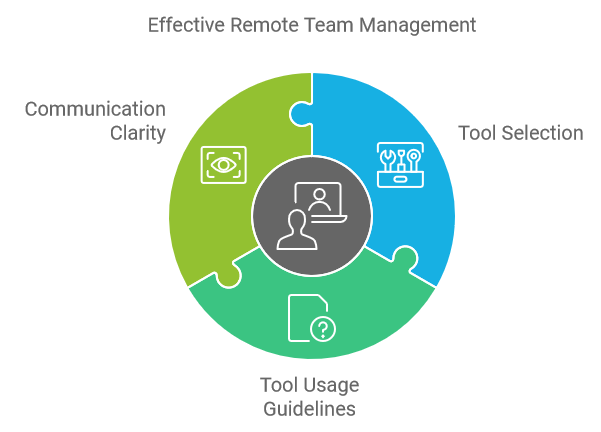
There are dozens of tools you can use for managing a remote team. It’s easy to get carried away and land into tool overload. You may end up with a confusing mix of tools that your team does not know how and when to use.
Many of these have overlapping features and functionalities. For example, you can use both Slack and Zoom to make video calls so if you have both, which one should be used for video calls? So it’s important that you carefully select a list of tools and also define how to use these. Without this clarity, each team member will use a tool or app he is comfortable using. Just imagine if some of your team members use WhatsApp for messaging while others use Slack. It will definitely lead to lost messages and confusion.
Check out this blog post for a good review of Remote collaboration tools.
5. Don’t forget to leverage one-to-one text messaging

In an office, someone who is not comfortable speaking in a team meeting can walk up to you to share his views. But it’s difficult to do in a virtual setup. They need to be able to discuss in a one-to-one setting. The best way to do that in a remote team is to use messaging tools that allow people to communicate with each other outside the group. It could be Slack, WhatsApp, or something else.
6. Use virtual team-building activities
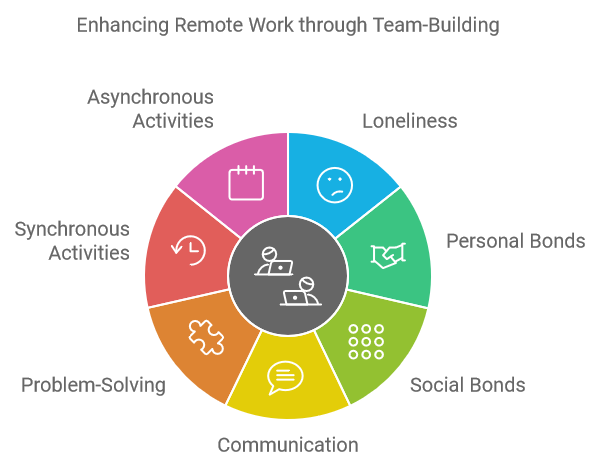
Loneliness is perhaps the biggest problem faced by remote workers. It can cause disengagement, drop in performance/productivity, even employee turnover. Loneliness can also push some individuals to take extreme actions.
The only way to break loneliness is to build personal and social bonds between team members. By connecting with others, team members can communicate better with each other, discuss issues, and find solutions to problems before they become too big.
Just like there are team-building activities for people working in an office, there are activities for team building in virtual teams. You can conduct both synchronous and asynchronous activities. Atlassian put together a list of some activities you can try in your team. There are also specialized companies like TeamBuilding that can design and conduct these programs for your team.
7. Celebrate individual and team events/achievements
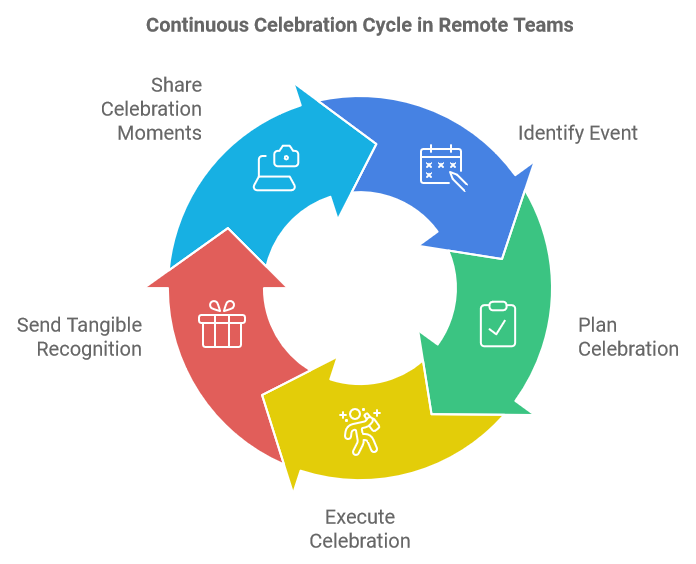
When in office, we celebrate all kinds of things – birthdays, festivals, sports events, and achievements. But most remote teams forget to do that as it’s hard to do that. People think there is no point in celebrating a birthday with your virtual team when you can’t cut the cake. Or celebrate a festival when you can’t get together to decorate the office or have a meal together. But good teams find a way to do it, even if it’s just singing “Happy Birthday to You” or sharing photos of how they celebrated a festival.
Celebrate individual and team achievements. Send physical cards/gifts that people can touch and feel. Don’t replace physical certificates as people tend to connect better with something tangible.
8. Set up a virtual water cooler
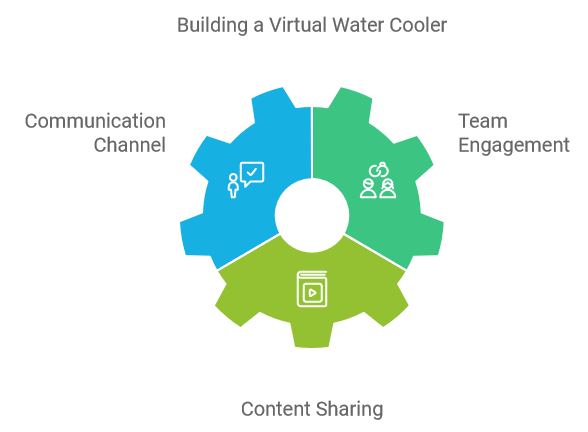
We all are familiar with the role of a water cooler in the office. It not only quenches thirst but also is a hot spot for people to hang out. It’s the place where people discuss everything under the sun, including work. Ware cooler discussions are a great way for people to learn about each other and build a relationship around shared values and interests.
You can create a virtual equivalent by setting up a separate channel in your messaging tool or creating a public discussion board. But setting up the channel or board is just the start. You need to get your team members to use it. You need to be deliberate about encouraging others to take part by being an active participant yourself. You may have to ask others to take part initially till it gets traction with everyone.
People can post about the food they cook, share vacation pictures, news about their family, and even jokes. Let them post about anything that will not be a legal liability for your business.
9. Set-up support system for the team
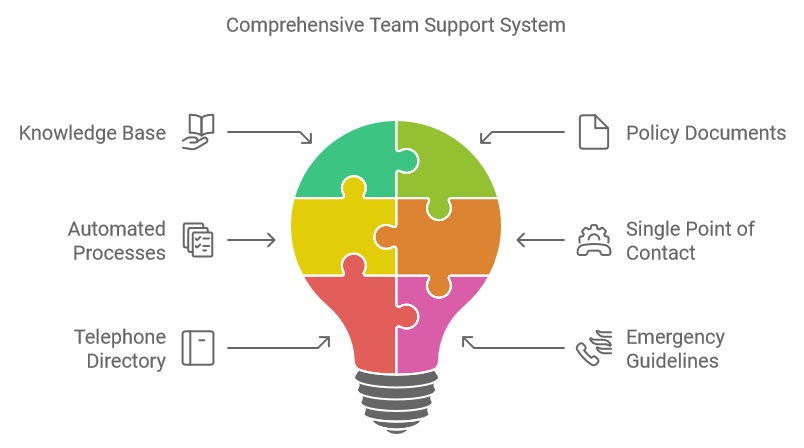
Set up a support system for tools and processes that your team uses. You can create a knowledge base / FAQ about how to set up and use the tools. Most tools you use will have their own support systems like self-help portal and customer support. But you may still want to supplement it by creating content that focuses on how your businesses use the tools.
Publish and share links to policy documents and processes so people can find them easily. Automate your routine processes such as applying for leave. Set up a single point of contact in the team for coordinating any help the team members need.
It’s a good idea to create a telephone directory and with everyone’s contact details. Set up clear guidelines on who to contact and what to do in case of an emergency.

